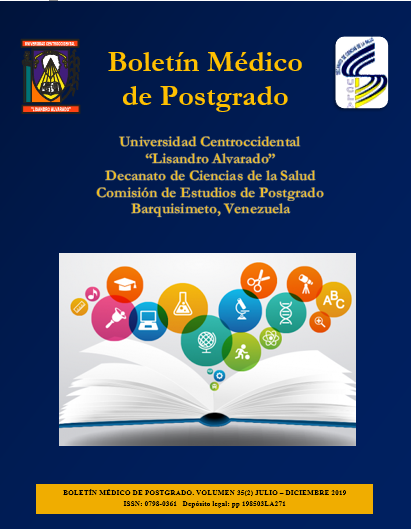Training program on electrical cardioversion at the Electrocardiology Unit of the CCR-ASCARDIO
Keywords:
cardioversion, arrhythmias, training, educationAbstract
Cardiovascular diseases are one of the main causes of mortality worldwide being heart rhythm disorders one of the most frequent cardiac pathologies. Electrical cardioversion is a technique that allows the transfer of electrons to the myocardium in order to interrupt arrhythmias with reentry mechanisms allowing the sinus node to take control of heart rate. The appropriate selection of cases susceptible to electrical cardioversion as well as experience on this technique increases the success rate and decreases the number of failed attempts. The Electrocardiology unit of the CCR-ASCARDIO has experience in the study and treatment of arrhythmias. In this article we present the development of a training program on electrical cardioversion, essential tool for cardiologists, with the aim to increase the correct use of this technique in order to prevent complications due to heart rhythm disorders.
Downloads
References
2. Falcón R. Ascardio como centro de formación cardiológica. Artículo especial. Avances Cardiol 2013; 33(1): S18-S26.
3. Bastidas A. Reseña histórica de la Cardiología en el Estado Lara, Venezuela. Nacimiento y desarrollo de ASCARDIO. Artículo especial. Avances Cardio 2013; 33(1): S10-S17.
4. Mittal S, Ayati S, Stein KM, et al. Transthoracic cardioversion of atrial fibrillation. Comparison of rectilinear biphasic versus damped sane wave monophasic shocks. Circulation 2000; 101:1282-7.
5. Dalzell G, et al. Electrode pad size, transthoracic impedance and success of external ventricular defibrillation. Am J Cardiol 1989; 64: 741--4.
6. Connell P, et al. Transtoracic impedance of defibrillator discharge: Effect of electrode size and electrodechest wall interface. J Electrocardiol 1973; 6: 313-6.
7. Lown B, Perlroth M, Kaidbey S, et al. Cardioversion of atrial fibrillation. A report on the treatment of 65 episodes in 50 patients. N Eng J Med 1963; 269: 325-31.
8. Dahl C, et al. Myocardial necrosis from direct current countershock. Effect of paddle electrode size and time interval between discharges. Circulation 1974; 50: 956-61.
9. Jose A, Joglar M, Robert C. Electrical cardioversion of atrial fibrillation. Cardiol Clin 2004; 22: 314-7.
10. Ricard P, Levy S, Trigano J, et al. Prospective assessment of the minimum energy needed for external electrical cardioversion of atrial fibrillation. Am J Cardiol 1997; 79: 815-6.
11. Lesser M. Safety and efficacy of in office cardioversion for treatment of supraventricular arrhythmias. Am J Cardiol 1990; 66:1267-8.
12. Van Gelder I, Crijns H, Van der LA, et al. Incidence and clinical significance of ST segment elevation alter electrical cardioversion of atrial fibrillation and atrial flutter. Am Heart J 1991; 121: 51-6.
13. Pagan-Carlo, Stone M, Kerber R. Nature and determinants of skin burns after transthoracic cardioversion. Am J Cardiol 1997; 79:689---91
14. Deborah W. Treatment of arrhythmias during pregnancy. Curr Womens Health Rep 2003; 3: 135-9.
15. Nolan J, et al. European Resuscitation Council Guidelines for Resuscitation 2010 Section 1. Executive summary. Resuscitation 2010; 81: 1219–1276.
Published
How to Cite
Issue
Section
Las opiniones expresadas por los autores no necesariamente reflejan la postura del editor de la publicación ni de la UCLA. Se autoriza la reproducción total o parcial de los textos aquí publicados, siempre y cuando se cite la fuente completa y la dirección electrónica de esta revista. Los autores(as) tienen el derecho de utilizar sus artículos para cualquier propósito siempre y cuando se realice sin fines de lucro. Los autores(as) pueden publicar en internet o cualquier otro medio la versión final aprobada de su trabajo, luego que esta ha sido publicada en esta revista.



